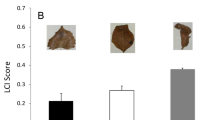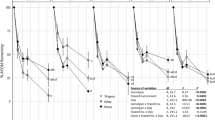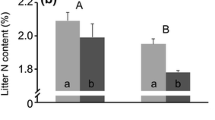Abstract
The effects of plant genetics on predators, especially those not living on the plant itself, are rarely studied and poorly understood. Therefore, we investigated the effect of plant hybridization and genotype on litter-dwelling spiders. Using an 18-year-old cottonwood common garden, we recorded agelenid sheet-web density associated with the litter layers of replicated genotypes of three tree cross types: Populus fremontii, Populus angustifolia, and their F1 hybrids. We surveyed 118 trees for agelenid litter webs at two distances from the trees (0–100 and 100–200 cm from trunk) and measured litter depth as a potential mechanism of web density patterns. Five major results emerged: web density within a 1-m radius of P. angustifolia was approximately three times higher than within a 1-m radius of P. fremontii, with F1 hybrids having intermediate densities; web density responded to P. angustifolia and F1 hybrid genotypes as indicated by a significant genotype × distance interaction, with some genotypes exhibiting a strong decline in web density with distance, while others did not; P. angustifolia litter layers were deeper than those of P. fremontii at both distance classes, and litter depth among P. angustifolia genotypes differed up to 300 %; cross type and genotype influenced web density via their effects on litter depth, and these effects were influenced by distance; web density was more sensitive to the effects of tree cross type than genotype. By influencing generalist predators, plant hybridization and genotype may indirectly impact trophic interactions such as intraguild predation, possibly affecting trophic cascades and ecosystem processes.



Similar content being viewed by others
References
Arim M, Marquet PA (2004) Intraguild predation: a widespread interaction related to species biology. Ecol Lett 7:557–564
Bailey JK, Bangert RK, Schweitzer JA, Trotter T III, Shuster SM, Whitham TG (2004) Fractal geometry is heritable in trees. Evolution 58:2100–2102
Bangert RK, Allan GJ, Turek RJ, Wimp GM, Meneses N, Martinsen GD, Keim P, Whitham TG (2006a) From genes to geography: a genetic similarity rule for arthropod community structure at multiple geographic scales. Mol Ecol 15:4215–4228
Bangert RK, Turek RJ, Rehill B, Wimp GM, Schweitzer JA, Allan GJ, Bailey JK, Martinsen GD, Keim P, Lindroth RL, Whitham TG (2006b) A genetic similarity rule determines arthropod community structure. Mol Ecol 15:1379–1391
Barbour RC, Baker SC, O’Reilly-Wapstra JM, Harvest TM, Potts BM (2009a) A footprint of tree-genetics on the biota of the forest floor. Oikos 118:1917–1923
Barbour RC, Forster LG, Baker SC, Steane DA, Potts BM (2009b) Biodiversity consequences of genetic variation in bark characteristics within a foundation tree species. Conserv Biol 23:1146–1155
Beatty SW, Sholes ODV (1988) Leaf litter effect on plant species composition of deciduous forest treefall pits. Can J For Res 18:553–559
Benjamini Y, Hochberg Y (1995) Controlling the false discovery rate: a practical and powerful approach to multiple testing. J R Stat Soc B 57:289–300
Bennett RG, Ubick D (2005) Agelenidae. In: Ubick D, Paquin P, Cushing PE, Roth V (eds) Spiders of North America: an identification manual. Am Arachnol Soc, pp 56–59
Bultman TL, Uetz GW (1982) Abundance and community structure of forest floor spiders following litter manipulation. Oecologia 55:34–41
Busby PE, Newcombe G, Dirzo R, Whitham TG (2013) Genetic basis of pathogen community structure for foundation tree species in a common garden and in the wild. J Ecol 101:867–877
Busby PE, Newcombe G, Dirzo R, Whitham TG (2014) Differentiating genetic and environmental drivers of plant–pathogen community interactions. J Ecol 102:1300–1309. doi:10.1111/1365-2745.12270
Chen B, Wise DH (1999) Bottom-up limitation of predaceous arthropods in a detritus-based terrestrial food web. Ecology 80:761–772
Classen AT, DeMarco J, Hart SC, Whitham TG, Cobb NS, Koch GW (2006) Impacts of herbivorous insects on decomposer communities during the early stages of primary succession in a semi-arid woodland. Soil Biol Biochem 38:972–982
Conner JK, Hartl DL (2004) A primer of ecological genetics. Sinauer, Sunderland
Crutsinger GM, Sanders NJ, Classen AT (2009) Comparing intra- and inter-specific effects on litter decomposition in an old-field ecosystem. Basic Appl Ecol 10:535–543
Crutsinger GM, Strauss SY, Rudgers JA (2010) Genetic variation within a dominant shrub species determines plant species colonization in a coastal dune ecosystem. Ecology 91:1237–1243
Drew AE, Roderick GK (2005) Insect biodiversity on plant hybrids within the Hawaiian silversword alliance (Asteraceae: Heliantheae-Madiinae). Environ Entomol 34:1095–1108
Driebe EM, Whitham TG (2000) Cottonwood hybridization affects tannin and nitrogen content of leaf litter and alters decomposition. Oecologia 123:99–107
Eisenbach J (1996) Three-trophic-level interactions in cattail hybrid zones. Oecologia 105:258–265
Farrer EC, Goldberg DE (2009) Litter drives ecosystem and plant community changes in cattail invasion. Ecol Appl 19:398–412
Finke DL, Denno RF (2006) Spatial refuge from intraguild predation: implications for prey suppression and trophic cascades. Oecologia 149:265–275
Frick H, Nentwig W, Kropf C (2007) Influence of stand-alone trees on epigeic spiders (Araneae) at the alpine timberline. Ann Zool Fenn 44:43–57
Fritz RS, Price PW (1988) Genetic variation among plants and insect community structure: willows and sawflies. Ecology 69:845–856
Gangon A, Heimpel GE, Brodeur J (2011) The ubiquity of intraguild predation among predatory arthropods. PLoS ONE 6:1–7
Hairston NG, Smith FE, Slobodkin LB (1960) Community structure, population control, and competition. Am Nat 94:421–425
Halaj J, Cady AB, Uetz GW (2000) Modular habitat refugia enhance generalist predators and lower plant damage in soybeans. Biol Control 29:383–393
Haloin JR, Strauss SY (2008) Interplay between ecological communities and evolution: review of feedbacks from microevolutionary to macroevolutionary scales. Ann N Y Acad Sci 1133:87–125
Hersch-Green EL, Turley NE, Johnson TJ (2011) Community genetics: what have we accomplished and where should we be going? Philos Trans R Soc B 366:1453–1460
Janetos AC (1982) Foraging tactics of two guilds of web-spinning spiders. Behav Ecol Sociobiol 10:19–27
Johnson MTJ, Agrawal AA (2005) Plant genotype and environment interact to shape a diverse arthropod community on evening primrose (Oenothera biennis). Ecology 86:874–885
Karban R (1989) Fine-scale adaptation of herbivorous thrips to individual host plants. Nature 340:60–61
Keith AR, Bailey JK, Whitham TG (2010) A genetic basis to community repeatability and stability. Ecology 91:3398–3406
Lamit LJ, Bowker MA, Holeski LM, Næsborg RR, Wooley SC, Zinkgraf M, Lindroth RL, Whitham TG, Gehring CA (2011a) Genetically-based trait variation within a foundation tree species influences a dominant bark lichen. Fungal Ecol 4:103–109
Lamit LJ, Wojtowicz T, Kovacs Z, Wooley SC, Zinkgraf M, Whitham TG, Lindroth RL, Gehring CA (2011b) Hybridization among foundation tree species influences the structure of associated understory plant communities. Botany 89:165–174
Lawrence KL, Wise DH (2000) Spider predation on forest-floor Collembola and evidence for indirect effects on decomposition. Pedobiologia 44:33–39
Lawrence KL, Wise DH (2004) Unexpected indirect effect of spiders on the rate of litter disappearance in a deciduous forest. Pedobiologia 48:149–157
LeRoy CJ, Whitham TG, Keim P, Marks JC (2006) Plant genes link forests and streams. Ecology 87:255–261
LeRoy CJ, Whitham TG, Wooley SC, Marks JC (2007) Within-species variation in foliar chemistry influences leaf-litter decomposition in a Utah river. J N Am Benthol Soc 26:426–438
Loeser MR, McRae BH, Howe MM, Whitham TG (2006) Litter hovels as havens for riparian spiders in an unregulated river. Wetlands 26:13–19
Lojewski NR, Fischer DG, Bailey JK, Schweitzer JA, Whitham TG, Hart SC (2009) Genetic basis of aboveground productivity in two native Populus species and their hybrids. Tree Physiol 29:1133–1142
Madritch MD, Hunter MD (2005) Phenotypic variation in oak litter influences short- and long-term nutrient cycling through litter chemistry. Soil Biol Biochem 37:319–327
Martinsen GD, Whitham TG, Turek RJ, Keim P (2001) Hybrid populations selectivity filter gene introgression between species. Evolution 55:1325–1335
McNett BJ, Rypstra AL (2000) Habitat selection in a large orb-weaving spider: vegetational complexity determines site selection and distribution. Ecol Entomol 25:423–432
Polis GA, McCormick SJ (1987) Intraguild predation and competition among desert scorpions. Ecology 68:332–343
Polis GA, Myers CA, Holt RD (1989) The ecology and evolution of intraguild predation: potential competitors that eat each other. Annu Rev Ecol Syst 20:297–330
Prestwich KN (1977) The energetics of web-building in spiders. Comp Biochem Physiol 57A:321–326
Pringle RM, Fox-Dobbs K (2008) Coupling of canopy and understory food webs by ground-dwelling predators. Ecol Lett 11:1328–1337
R Development Core Team (2012) R: a language and environment for statistical computing. R Foundation for Statistical Computing, Vienna
Riechert SE (1974) The pattern of local web distribution in a desert spider: mechanisms and seasonal variation. J Anim Ecol 43:733–746
Riechert SE (1976) Web-site selection in the desert spider Agelenopsis aperta. Oikos 27:311–315
Riechert SE (1979) Games spider play. II. Resource assessment strategies. Behav Ecol Sociobiol 6:121–128
Riechert SE (1981) The consequences of being territorial: spiders, a case study. Am Nat 117:871–891
Riechert SE, Bishop L (1990) Prey control by and assemblage of generalist predators: spiders in garden test systems. Ecology 71:1441–1450
Riechert SE, Tracy CR (1975) Thermal balance and prey availability: bases for a model relating web-site characteristics to spider reproductive success. Ecology 56:265–284
Riechert SE, Roeloffs R, Echternacht AC (1986) The ecology of the cooperative spider Agelena consociata in equatorial Africa (Araneae, Agelenidae). J Arachnol 14:175–191
Romero GQ, Vasconcellos-Neto J (2004) Beneficial effects of flower-dwelling predators on their host plant. Ecology 85:446–457
Rosenheim JA, Wilhoit LR, Armer C (1993) Influence of intraguild predation among generalist insect predators on the suppression of an herbivore population. Oecologia 96:439–449
SAS Institute (2012) JMP version 10.0. SAS Institute, Cary
Scheu S, Poser G (1996) The soil macrofauna (Diplopoda, Isopods, Lumbricidae and Chilopods) near tree trunks in a beechwood on limestone: indications for stem flow induced changes in community structure. Appl Soil Ecol 3:115–125
Schmidt JM, Rypstra AL (2010) Opportunistic predator prefers habitat complexity that exposes prey while reducing cannibalism and intraguild encounters. Oecologia 164:899–910
Schweitzer JA, Bailey JK, Rehill BJ, Martinsen GD, Hart SC, Lindroth RL, Keim P, Whitham TG (2004) Genetically based trait in a dominant tree affects ecosystem processes. Ecol Lett 7:127–134
Schweitzer JA, Bailey JK, Fischer DG, LeRoy CJ, Lonsdorf EV, Whitham TG, Hart SC (2008) Plant–soil–microorganism interactions: heritable relationships between plant genotype and associated soil microorganisms. Ecology 89:773–781
Snyder WE, Wise DH (2001) Contrasting trophic cascades generated by a community of generalist predators. Ecology 82:1571–1583
Stevenson BG, Dindal DL (1982) Effect of leaf shape on forest litter Collembola: community organization and microhabitat selection of two species. J Ga Entomol Soc 17:363–369
Strauss SY (1994) Levels of herbivory and parasitism in host hybrid zones. Trends Ecol Evol 9:209–214
Tack AJM, Johnson MTJ, Roslin T (2012) Sizing up community genetics: it’s a matter of scale. Oikos 121:481–488
Tanaka K (1989) Energetic cost of web construction and its effect on web relocation in the web-building spider Agelena limbata. Oecologia 81:459–464
Ubick D, Paquin P, Cushing PE, Roth V (eds) (2005) Spiders of North America: an identification manual. American Arachnological Society
Uetz GW (1975) Temporal and spatial variation in species diversity of wandering spiders (Araneae) in deciduous forest litter. Environ Entomol 4:719–724
Uetz GW (1979) The influence of variation in the litter habitats on spider communities. Oecologia 40:29–42
Waite TA, Campbell LG (2006) Controlling the false discovery rate and increasing statistical power in ecological studies. Ecoscience 13:439–442
Whitham TG, Martinsen GD, Floate KD, Dungey HS, Potts BM, Keim P (1999) Plant hybrid zones affect biodiversity: tools for a genetic-based understanding of community structure. Ecology 80:416–428
Whitham TG, Gehring CA, Lamit LJ, Wojtowicz T, Evans LM, Keith AR, Smith DS (2012) Community specificity: life and afterlife effects of genes. Trends Plant Sci 17:271–281
Wimp GM, Young WP, Woolbright SA, Martinsen GD, Keim P, Whitham TG (2004) Conserving plant genetic diversity for dependent animal communities. Ecol Lett 7:776–780
Wimp GM, Martinsen GD, Floate KD, Bangert RK, Whitham TG (2005) Plant genetic determinants of arthropod community structure and diversity. Evolution 59:61–69
Wimp GM, Wooley S, Bangert RK, Young WP, Martinsen GD, Keim P, Rehill B, Lindroth RL, Whitham TG (2007) Plant genetics predicts intra-annual variation in phytochemistry and arthropod community structure. Mol Ecol 16:5057–5069
Zytynska SE, Fay MF, Penney D, Preziosi RF (2011) Genetic variation in a tropical tree species influences the associated epiphytic plant and invertebrate communities in a complex forest ecosystem. Philos Trans R Soc B 366:1329–1336
Acknowledgments
We thank the Ogden Nature Center staff, especially M. McKinley, for supporting the common garden and for field accommodations. We also thank the Gehring lab, the Cottonwood Ecology Research Group, and three anonymous reviewers for helpful comments on the manuscript. This studied benefited from the field assistance provided by C. Sanfiorenzo-Barnhard, C. VanCamp, and B. Harrop, and statistical assistance from M. Lau. This research was supported by the National Science Foundation Frontiers in Integrative Biological Research grant (DEB-0425908) to the Cottonwood Ecology Research Group and MRI (DBI-1126840) for the Southwest Experimental Garden Array.
Author information
Authors and Affiliations
Corresponding author
Additional information
Communicated by Amy Austin.
Electronic supplementary material
Below is the link to the electronic supplementary material.
Rights and permissions
About this article
Cite this article
Wojtowicz, T., Compson, Z.G., Lamit, L.J. et al. Plant genetic identity of foundation tree species and their hybrids affects a litter-dwelling generalist predator. Oecologia 176, 799–810 (2014). https://doi.org/10.1007/s00442-014-2998-3
Received:
Accepted:
Published:
Issue Date:
DOI: https://doi.org/10.1007/s00442-014-2998-3




